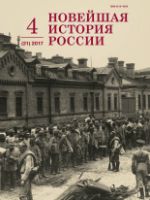«Танковое дело» 1949 г.: механизм решения проблем оборонной промышленности в послевоенный период
The “Tank Affair” of 1949: How Problems of the Defensive Industry were Solved during the Post-War Period
Author(s): A. N. FedorovSubject(s): Military history, Government/Political systems, WW II and following years (1940 - 1949)
Published by: Издательство Исторического факультета СПбГУ
Keywords: Tank Industry; Post-War Period; Kirov Plant; Uralvagonzavod; Purges; Mobilization Economy; J.V. Stalin; V.A. Malyshev; L.Z. Mehlis; I.M. Zaltzman;
Summary/Abstract: The article considers measures taken by the USSR top leadership in 1949 to resolve the most acute problems of the Soviet tank industry. Emergency intervention in the affairs of this defense industry was due to the fact that from 1946 to 1948 it was in crisis. Due to a number of objective problems, its enterprises could not successfully develop new types of armored vehicles and produce them in the needed quantities. This crisis was compounded by the fact that senior management did not sufficiently delve into the problem of the tank industry. The situation changed at the beginning of 1949, when the aggravation of international relations strengthened Stalin’s attention to the defense industry and information on the failures in the tank industry reached him. Because Stalin was personally involved in this issue, in the shortest time all levels of government (the Council of Ministers, ministries and enterprise management) were mobilized. The Bureau under the USSR Council of Ministers was established to give more effective control and coordination of the work of the tank industry. The supervision of all tank questions was provided by the best professionals in this sphere: V.A. Malyshev and E.Yu. Maksarev. For more successful mobilization of managers, various individual punishments were administered, the most severe and demonstrative of which was the resignation of the director of the Kirov plant I.M. Zaltsman. However, largescale personnel purges were not carried out, as they could disorganize the work of the industry. All these measures, along with the allocation of additional material resources and inter-departmental struggle, made it possible already by the end of 1949 to upgrade new tank models and prepare for their mass production. However, other important problems of the tank industry remained unresolved.
Journal: Новейшая история России
- Issue Year: 7/2017
- Issue No: 21
- Page Range: 69-86
- Page Count: 18
- Language: Russian

